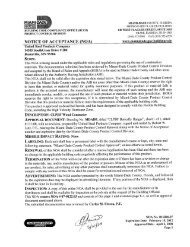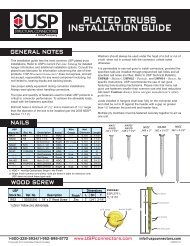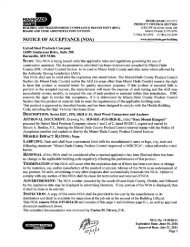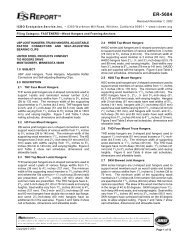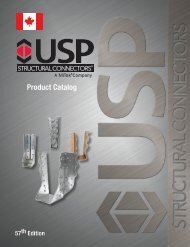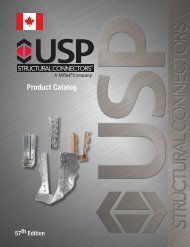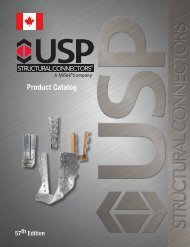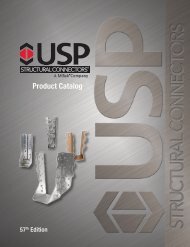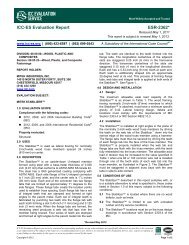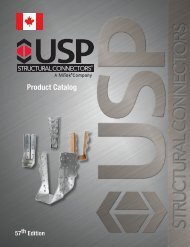EWP Hangers - USP Connectors
EWP Hangers - USP Connectors
EWP Hangers - USP Connectors
You also want an ePaper? Increase the reach of your titles
YUMPU automatically turns print PDFs into web optimized ePapers that Google loves.
Support Height & Lateral Stability<br />
© Copyright 2013 <strong>USP</strong> Structural <strong>Connectors</strong> ®<br />
<strong>Hangers</strong> for joists without web stiffeners must support the<br />
I-Joist’s top flange and provide lateral resistance with no<br />
more than 1⁄8˝ horizontal deflection.<br />
1/8˝ (3.175 mm)<br />
maximum gap<br />
Nailer Installations<br />
Resist lateral movement<br />
Web stiffener<br />
Correct Hanger Attachment to Nailer<br />
A nailer or sill plate is considered to be any wood member attached to a steel beam,<br />
concrete block wall, concrete stem wall, or other structure unsuitable for nailing, which<br />
is used as a nailing surface for top mount hangers to hold beams or joists.<br />
Nailer Sized Correctly<br />
Top flange of hanger is fully supported and recommended nails have full<br />
penetration into nailer, resulting in a carried member hanging safely at the proper<br />
height.<br />
The nailer must be sized to fit the support width as shown and be of sufficient thickness<br />
to satisfy recommended top flange nailing requirements. A design professional must<br />
specify nailer attachment to steel beams.<br />
<strong>Hangers</strong> for joists with web stiffeners must support a<br />
minimum of 60% of joist depth or potential joist rotation must<br />
be addressed.<br />
(Top flange support requirements can be verified in this sections charts under the Web Stiffener Reqd. column.)<br />
1/4˝<br />
(6.35<br />
mm)<br />
Max.<br />
Avoid direct contact between<br />
hangers and steel beams, which<br />
may cause squeaks<br />
Joist<br />
depth<br />
60% min. of<br />
joist depth<br />
<strong>EWP</strong> <strong>Hangers</strong><br />
Wrong Nailer Size Causes Component Failure<br />
1/4˝ ( 6.35mm) Max.<br />
! Too Narrow<br />
! Too Wide<br />
! Too Thin<br />
Top flange not fully supported can Loading can cause cross grain Top flange nailing cannot fully<br />
cause nail breakout. Or, by fully breaking of nailer. The penetrate nailer, causing reduced<br />
supporting top flange, hanger is<br />
tilted back, causing lifting of carried<br />
member which results in uneven<br />
surfaces and squeaky floors.<br />
recommended nailer overhang<br />
is 1⁄4˝ maximum per side.<br />
factored resistance. Never use<br />
hangers which require multiple face<br />
nails since the factored resistance<br />
are dependent on all nail holes being<br />
used.<br />
1-800-328-5934 • www.<strong>USP</strong>connectors.com 117<br />
<strong>USP</strong>2240-131



